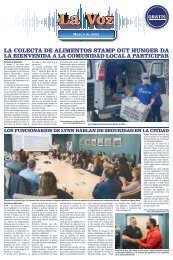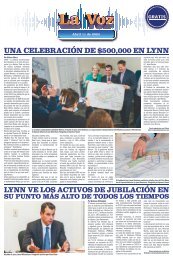Create successful ePaper yourself
Turn your PDF publications into a flip-book with our unique Google optimized e-Paper software.
JUNE 11, 2020
Anxiety is one of the biggest
emotional health challenges
facing our children and teens.
It can destroy their self-esteem,
reduce joy, and interfere with,
or even sabotage, them from
taking healthy risks in life.
Being a calming, skilled, and
steadying influence to help your
children learn to manage anxiety
is a valuable lifelong gift
that you can provide to them.
Here are seven strategies to
help your children manage their
anxiety:
1) Closely listen and observe
your teen. True panic attacks
include shortness of breath,
WEEKLYNEWS.NET - 978-532-5880 9
Six Tips to help lower teen anxiety
heart palpitations, dizziness,
dry mouth, nausea, or diarrhea,
high levels of muscle tension,
and possibly an irrational fear
that he or she will die. If your
child is panicking, encourage
slow deep breaths, be reassuring
and non-judgmental.
2) Be patient, present, and
soothing. Use consistent eye
contact, active listening, and
a warm accepting demeanor.
Gently encourage your child to
reflect on positive memories,
personal strengths, and valued
past accomplishments.
3) Listen for irrational
thoughts (e.g., “My future is ruined”,
“I can never get anyone
to like me”, “No one ever takes
me seriously”, “I suck in everything
I do”, “Everyone in the
school is going to talk about
this all the time for the next ten
years.”).
4) Help your child to see that
irrational self-talk raises anxiety
(or even lesser forms of worry)
off the charts. Explain how, like
a snowball rolling down a hill,
the more he or she dwells on
negative thoughts, the larger the
snowball will grow.
5) Coach your child or teen
to realize the lack of evidence
for irrational (unhelpful)
thoughts and help him or her
find evidence for more rational
(helpful) thoughts. So,
for example, point out how the
student is not a total failure or
total loser or totally unpopular.
Go back in time and point out
times when the problem did
not exist and when the current
problem does not exist.
Finding such exceptions to the
rule is very helpful.
6) Point out how “What is the
worst thing that can happen?”
is a more helpful question than,
“What if?” Explain how worries
often begin with “What if”
and that these worries can often
be squashed when realistically
considering how the worst case
scenario is not likely to actually
happen. Even if the worst
case scenario occurs, it may be
upsetting but not the end of the
world.
Reprinted from Psychology
Today and posted on the
Lynnfield School Department
website.
http://www.psychologytoday.
com/blog/liking-the-child-youlove/201312/seven-quick-tipsloweryour-childs-or-teens-anxiety
Repetitive motion injuries during COVID-19
By Dr. Sanjeev Kakar
A patient wrote this letter:
“Earlier this year, I began experiencing
some pain in my right
hand and wrist. I am a systems
engineer and have always done
a fair amount of typing at work.
Now with the COVID-19 pandemic,
I am working at home
and spending even more time
on a keyboard. I’m finding the
pain has increased, and I’m also
having some new tingling and
numbness in my hand and wrist.
I heard about carpal tunnel and
was wondering if I may have it.
If I do have carpal tunnel, what
can I do to help or reverse it?”
Answer: There are various
things that can cause hand and
wrist discomfort. Feelings of
pins and needles, or a sensation
of tingling or prickling,
can occur in the hands due to
pressure on nerves, which are
like electrical cables that in part
give feeling to your fingers.
The exact area of discomfort
and symptoms will guide which
condition you likely have. Are
your symptoms occurring all
day or only at certain times?
Are you having pain only while
typing?
Given the situation you describe,
it’s most likely you
are experiencing one of two
common ailments that have
become more common in the
age of technology. The first is
a type of tendonitis known as
De Quervain’s tenosynovitis.
This is considered an overuse
injury caused by repetitive hand
or wrist motion. The second
possibility sounds like it could
be carpal tunnel syndrome.
Activities such as typing or texting,
golfing, and gardening can
worsen these conditions.
De Quervain’s tenosynovitis
affects the tendons on the
thumb side of your wrist. You
may have swelling in this area
and pain that is exacerbated
when you twist your wrist,
grasp or lift something heavy
like a milk jug.
Carpal tunnel syndrome is a
condition that can create numbness
and a sensation of tingling
in your fingers. It occurs when
the median nerve, which is on
the palm side of the hand, is
compressed or irritated in some
way. Symptoms typically are
limited to your thumb, index
finger, middle finger and thumb
side of your ring finger.
If you feel tingling along the
inner aspect of your forearm
down to your pinky finger,
carpal tunnel is not likely the
cause. Rather, it may be that
you are suffering from cubital
tunnel, which is irritation of a
nerve by your inner elbow.
Many patients with carpal
tunnel report initial symptoms
at night, although as the condition
progresses, carpal tunnel
can cause weakness of the
thumb’s pinching muscles and
lead to difficulties performing
routine tasks. Some patients
have reported numbness in their
hand that is exasperated, for instance,
while holding a phone
or driving.
If your symptoms are related
to De Quervain’s tenosynovitis,
using ice for swelling and
taking a mild pain reliever can
help with discomfort.
The best treatment, though,
is to reduce the activity that is
most likely causing your symptoms.
While that can be challenging
now, especially if you
notice that your pain is exasperated
while you type, consider
using a voice-activated dictation
system or switch fingers if
you text a lot. For instance, if
you most often use your thumbs
to text and it has become more
painful, switch to using your
index fingers instead.
I also would recommend that
you perform an ergonomics
check of your at-home workspace.
Your posture can affect
how you function and develop
some of these symptoms.
Second, look at the position of
your wrist. If you are sitting or
standing at an awkward height,
your wrist could be in a significantly
flexed position that puts
pressure on the nerves and tendons,
and increases your risk
for issues and symptoms.
To help alleviate your carpal
tunnel like symptoms at night,
try an over-the-counter splint
with a metal reinforcement on
the palm side. This splint will
stop you from flexing your
RE-OPENING
SALE
Now through June 15
25-50 % OFF
ENTIRE STORE
wrist and reduce irritation on
the nerve.
If your symptoms progress,
talk with your health care
provider about next steps to
confirm your diagnosis and
the potential for other nonsurgical
treatments, such as hand
therapy or an injection.
From Mayo Clinic News
Network Mayo Clinic News
Network. Dr. Sanjeev Kakar
specializes in Orthopedic
Surgery at the Mayo Clinic,
Rochester, Minnesota.
Enjoy huge savings throughout the store!
Take advantage of this unique opportunity to save on
your favorite brands including all in-stock spring and
summer styles at end of season savings!
Give Giblees - Father’s Day is Sunday, June 21!
STORE HOURS Monday-Friday 10-6, Saturday 9-5, Sunday 12-5
85 Andover Street, Rt. 114, Danvers 978.774.4080 giblees.com
COME IN ONCE, YOU’LL BE A CUSTOMER FOR LIFE!

















